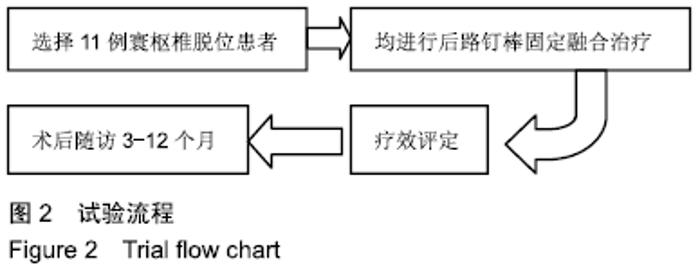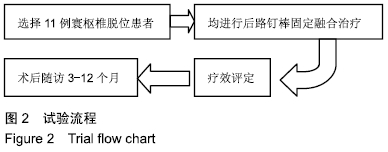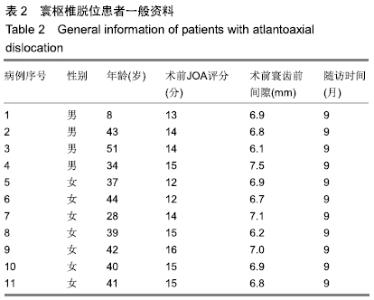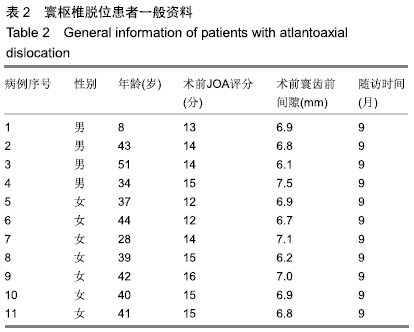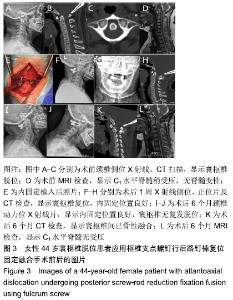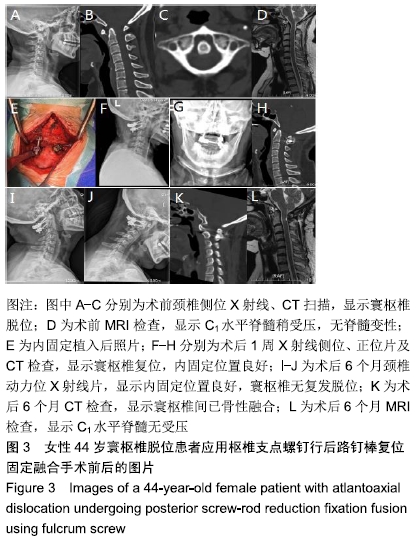[1] YIN QS, WANG JH.Current Trends in Management of Atlantoaxial Dislocation.Orthop Surg.2015;7(3):189-199.
[2] GOEL A, LAHERI V.Plate and screw fixation for atlanto-axial subluxation. Acta Neurochir(Wien).1994;129(1):47-53.
[3] HARMS J, MELCHER RP.Posterior C1-C2 fusion with polyaxial screw and rod fixation. Spine(Phila Pa 1976).2001; 26(22):2467-2471.
[4] ELLIOTT RE, TANWEER O, BOAH A, et al.Outcome comparison of atlantoaxial fusion with transarticular screws and screw-rod constructs: meta-analysis and review of literature.J Spinal Disord Tech.2014;27(1):11-28.
[5] GUAN J, CHEN Z, WU H, et al.Effectiveness of posterior reduction and fixation in atlantoaxial dislocation: a retrospective cohort study of 135 patients with a treatment algorithm proposal.Eur Spine J.2019;28(5):1053-1063.
[6] SINHA AK, GOYAL S.Myoarchitectonic advancement of the C2 spinous process for C1-C2 posterior fusion: A novel technique.J Neurosci Rural Pract.2015;6(2):267-271.
[7] MA XY, YIN QS, WU ZH, et al.Anatomic considerations for the pedicle screw placement in the first cervical vertebra. Spine(Phila Pa 1976).2005;30(13):1519-1523.
[8] DAVIDSON CT, BERGIN PF, VARNEY ET, et al.Planning C2 pedicle screw placement with multiplanar reformatted cervical spine computed tomography.J Craniovertebr Junction Spine. 2019;10(1):46-50.
[9] XU J, YIN Q, XIA H, et al.New clinical classification system for atlantoaxial dislocation.Orthopedics.2013;36:e95-e100.
[10] BHOWMICK DA, BENZEL EC.Posterior atlantoaxial fixation with screw-rod constructs: safety, advantages, and shortcomings.World Neurosurg.2014;81(2):288-289.
[11] MEYER B, KUHLEN D. Atlantoaxial fusion: transarticular screws versus screw-rod constructs. World Neurosurg. 2013; 80(5):516-517.
[12] STULIK J, VYSKOCIL T, SEBESTA P, et al.Atlantoaxial fixation using the polyaxial screw-rod system.Eur Spine J. 2007;16(4):479-484.
[13] GUO SL, ZHOU DB, YU XG, et al.Posterior C1-C2 screw and rod instrument for reduction and fixation of basilar invagination with atlantoaxial dislocation. Eur Spine J. 2014; 23(8):1666-1672.
[14] QI L, LI M, ZHANG S, et al.C1-c2 pedicle screw fixation for treatment of old odontoid fractures.Orthopedics.2015;38(2): 94-100.
[15] WANG C, YAN M, ZHOU HT, et al.Open reduction of irreducible atlantoaxial dislocation by transoral anterior atlantoaxial release and posterior internal fixation.Spine (Phila Pa 1976).2006;31:E306-313.
[16] SRIVASTAVA SK, AGGARWAL RA, NEMADE PS, et al. Single-stage anterior release and posterior instrumented fusion for irreducible atlantoaxial dislocation with basilar invagination.Spine J.2016;16:1-9.
[17] PENG X, CHEN L, WAN Y, et al.Treatment of primary basilar invagination by cervical traction and posterior instrumented reduction together with occipitocervical fusion.Spine(Phila Pa 1976).2011;36:1528-1531.
[18] WEI G, SHI C, WANG Z, et al.Surgical Outcome and Prognostic Analysis of Transoral Atlantoaxial Reduction Plate System for Basilar Invagination: A Voxel-Based Morphometry Studye.J Bone Joint Surg Am.2016,98:1729-1734.
[19] WEI G, WANG Z, AI F, et al.Treatment of Basilar Invagination With Klippel-Feil Syndrome: Atlantoaxial Joint Distraction and Fixation With Transoral Atlantoaxial Reduction Plate. Neurosurgery.2016,78:492-498.
[20] XIA H, YIN Q, AI F, et al.Treatment of basilar invagination with atlantoaxial dislocation: atlantoaxial joint distraction and fixation with transoral atlantoaxial reduction plate (TARP) without odontoidectomy.Eur Spine J.2014;23:1648-1655.
[21] 马向阳,杨进城,邱锋,等.不可复性寰枢椎脱位的临床分型及术式选择[J].中华骨科杂志,2015,35(5):474-480.
[22] HUANG DG, HAO DJ, HE BR, et al.Posterior atlantoaxial fixation: a review of all techniques Spine J. 2015;15(10): 2271-2281.
[23] 马向阳,尹庆水,吴增晖,等.多种寰枢椎后路钉棒固定技术的临床组合应用[J].中国骨科临床与基础研究杂志,2010,2(1):12-16.
[24] SIM HB, LEE JW, PARK JT, et al.Biomechanical evaluations of various c1-c2 posterior fixation techniques.Spine (Phila Pa 1976).2011;36:E401-E407.
[25] 马向阳,尹庆水,吴增晖,等.寰枢椎后路四种钉棒固定方法的三维稳定性评价[J].中国脊柱脊髓杂志,2008,18(6):464-468.
[26] SAVAGE JW, LIMTHONGKUL W, PARK HS, et al.A comparison of biomechanical stability and pullout strength of two C1-C2 fixation constructs. Spine J.2011;11(7):654-658.
[27] CLAYBROOKS R, KAYANJA M, MILKS R, et al.Atlantoaxial fusion: a biomechanical analysis of two C1-C2 fusion techniques.Spine J.2007;7(6):682-688.
[28] 王诗军,李钰婷,李淳德,等.后路内固定系统修复寰枢椎不稳的生物力学特征[J].中国组织工程研究,2015,19(48):7819-7824.
[29] YANG J, MA X, XIA H, et al.Transoral anterior revision surgeries for basilar invagination with irreducible atlantoaxial dislocation after posterior decompression:a retrospective study of 30 cases.Eur Spine J.2014;23:1099-1108.
[30] MA X, YIN Q, XIA H, et al.The application of atlantoaxial screw and rod fixation in revision operations for postoperative re-dislocation in children.Arch Orthop Trauma Surg. 2015;135: 313-319.
[31] 杨敏,马向阳,杨进城,等.自行防旋转寰枢椎钉棒内固定系统的生物力学有限元分析[J].中国组织工程研究,2017,21(19): 3031-3037.
[32] 古正涛,戴建强,吴增晖,等.经口寰枢椎术后肺部并发症的原因分析及预防措施[J].中国脊柱脊髓杂志,2010,20(8):660-663.
[33] 罗爱武,白朝晖,王艳,等.经口寰枢椎复位内固定患者术后医院感染危险因素分析及对策[J].中华医院感染学杂志, 2017,27(6): 1313-1316.
|
